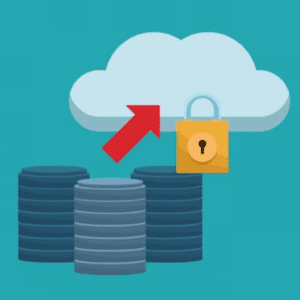Risk management is a crucial aspect of cloud-based banking systems to ensure the security and stability of these financial institutions. Cloud-based financial systems rely on cloud computing services and tools for day-to-day financial transactions and other operations. These cloud computing services on one hand provide benefits like scalability, cost-effectiveness, and flexibility. But, on the other hand, they also introduce some serious risks.

These risks need to be identified and managed for the proper functionality of banking operations. In this article, we will discuss the potential risks of a cloud-based banking system, the risk management process, and best practices for risk management in the cloud. Read the full article to get insights into risk management in cloud banking systems.
Types of Risks in Cloud Banking Systems
There are different types of risks associated with banking systems especially when a cloud-based system is involved. As financial institutions store sensitive data related to the financial and personal information of users.
That is why these risks need to be identified and necessary actions should be taken for financial institutions to have smooth operations. Here are the types of risks institutions may face in cloud-based banking systems.
Operational Risks
Important types of risks in a cloud banking system are operational risks. Operational risks refer to the problem that occurs in the cloud due to internal system failures, human errors, or external cyber-attacks.
IT failures
Cloud-based banking systems are dependent on cloud services for their day-to-day operation. That is why a strong IT infrastructure is needed to support operations all the time. Strong IT infrastructure does not guarantee smooth operations. There is always room for risks like outrages, low network latency, or any other technical problems. All of these IT failures result in huge financial losses and sometimes inefficient operations.
Cyber attacks
According to a survey, more than 2200 cyber attacks happen every day. The majority of the targets of these attacks are financial institutes like banks. A cloud-based banking system makes the system and information available on it more vulnerable to cyberattacks. Even a failed cyber attack can disrupt the operations of a financial institute. Despite continuous system upgrades, there is always a risk of a potential cyberattack which can lead to financial losses, data breaches, and disrupted operations.
Human errors
Human error is an important factor in operational risk. Employees may cause operational risks by giving control to unauthorized personnel, wrong data entry in the cloud, etc. All of these human errors can cause operational risk in a cloud-based banking system.
Compliance Risks
Cloud-based banking systems can also pose compliance risks. All financial institutions are required to fulfill some regulations by different government bodies to ensure the privacy of customers and continuous operations. These regulations include General Data Protection Regulation (GDPR), Federal Risk and Authorization Management Program (FedRAM), SEC, etc.
Cloud-based banking systems make it difficult for banks to comply with all these regulations by different bodies. This difficulty poses a compliance risk that can cost banks fines and restrictions. Continuous fines and restrictions from different government bodies and organizations cause financial loss and less trust among customers.
Reputation Risks
Reputational risks refer to the harm to the reputation a bank may face due to data breaches, System failures, compliance issues, service disruption, etc. All of these reputation risks are multiplied in cloud-based banking systems. Since the likelihood of cloud-based services being disrupted is higher than an on-premise infrastructure it poses more reputation risks.
All of the above risks can be controlled by proper risk management systems and by implementing best risk management practices.
Risk Management Process in Cloud Banking Systems

Risk management is an important process in cloud banking systems. It involves the identification of risks, Evaluation of risks, implementation, and monitoring of risks to improve the security of data and transaction details of users.
This risk management process helps FinTech institutions like cloud-based banking systems to ensure the security and confidentiality of sensitive financial information of their users.
Following are the phases of the risk management process in a cloud-based banking system.
Identification of Risks
The very first step in a risk management process is to identify the potential risks. Extensive research should be conducted to identify different types of risk in the cloud banking system. This includes thorough research of the cloud to identify types of tools and data stored. Once potential cloud risk has been identified next step is to calculate the impact.
Evaluation of Risk
The next step after the identification of potential risk is the risk assessment. This step includes the evaluation of all the potential risks identified in the previous step. Once all the potential risks have been evaluated it’s time to prioritize these risks based on their impact on the banks and customers. Risk largely affecting the security of financial institutions and their customers should be of high priority.
Implementation of Risk Mitigation Measures
After prioritizing the risks based on their impact it is time to tackle all of them one by one. These risks can not be eradicated but can be minimized by implementing risk management techniques. This includes setting firewalls to increase protection from external threats, allowing only authorized personnel to access the sensitive areas of the cloud, setting encryptions, having a disaster recovery plan, etc.
All of these risk management measures can ensure smooth operations in a cloud-based banking system.
Monitoring and Review
This risk management process should always be in motion. This will help banks smoother their operation without any disruptions. This risk management should always be monitored and reviewed for effectiveness because technology is constantly evolving. It is important to evolve a risk management plan in accordance with changing technology to ensure security and smooth operations.
Best Practices for Risk Management in Cloud Banking Systems
Best practices for risk management help ensure the security, flexibility, and availability of sensitive financial information required for operations in banks. These practices minimize the effects of terrible incidents on the cloud.
Strong access controls
Strong access control should be practiced by every bank whether it has on-premises infrastructure or cloud-based. Strong access controls are critical to ensure that the only person accessing the personal and financial information of banks and customers are authorized.
This can be ensured by implementing two-step authentication, and access numbers and codes. Also, access to employees fired or suspended from the bank should be revoked to prevent any data or identity theft incidents.
Regular security assessments
Regular security assessments are also a good practice for cloud-based banking systems for risk management. These assessments help financial organizations identify and eliminate vulnerabilities in their system. This assessment includes testing technology, process, and data for vulnerabilities. This security assessment is usually divided into 4 steps identifying the risks, assessing each risk, prioritizing risks, and mitigation.

These regular security assessments help financial organizations safeguard the financial and personal information of customers by eliminating any threat before it does any harm.
Data encryption
Implementing strong security measures is a crucial part of risk management. Using encryptions for data on the cloud and shared data is very important. It can help financial institutions prevent any important loss and theft. Apart from encryption, a two-step authentication system should also be introduced to allow the use of the cloud by authorized personnel only.
Apart from encryption firewalls are also important for the networks to prevent any network interception. Most of the time data breaches happen due to weak network security measures and firewalls will ensure network security.
Regular software updates and patches
Regular software updates and patches are an important aspect of risk management. Regular updates provide developers with the opportunity to eliminate vulnerabilities, fix bugs and enhance the performance of the cloud. These updates and patches are vital for the security of a cloud-based system. These updates allow developers to make their systems up to date according to the changing technology.
Compliance with regulatory requirements
The financial service sector is regulated by different government bodies due to its sensitivity and importance. Sometimes it can be hard to comply with all the regulatory requirements. But by implementing practices like regular security audits, real-time data sharing between the organizations, and choosing a reputed vendor all these regulator requirements can be fulfilled without any worries.
Therefore financial service institutions must implement these practices to easily comply with regulatory requirements.
Conclusion:
Risk management is an important aspect of cloud-based solutions to maintain stability, security, and continuous operations. There are different types of risks in a cloud-based solution like operational risks, compliance risks, reputation risks, etc. All of these risks can be controlled by the risk management system. A risk management system in the cloud consists of 4 steps identification, evaluation, prioritization, and mitigation.
Each of these steps is important for the elimination of these risks. To avoid these risks financial institutions can implement practices like strong access controls, data encryption, regular security assessments, and regular updates.






